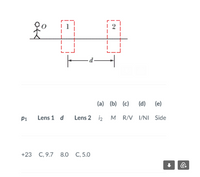
Two-lens systems. In the figure, stick figure O (the object) stands on the common central axis of two thin, symmetric lenses, which are mounted in the boxed regions. Lens 1 is mounted within the boxed region closer to O, which is at object distance p1. Lens 2 is mounted within the farther boxed region, at distance d. Each problem in the table refers to a different combination of lenses and different values for distances, which are given in centimeters. The type of lens is indicated by C for converging and D for diverging; the number after C or D is the distance between a lens and either of its focal points (the proper sign of the focal distance is not indicated). Find (a) the image distance i2 for the image produced by lens 2 (the final image produced by the system) and (b) the overall lateral magnification M for the system, including signs. Also, determine whether the final image is (c) real or virtual, (d) inverted from object O or noninverted, and (e) on the same side of lens 2 as object O or on the opposite side.

Trending nowThis is a popular solution!
Step by stepSolved in 3 steps

- A spherical, concave shaving mirror has a radius of curvature of 0.609 m. What is the image distance of a person's face when it is 0.155 m from the vertex of the mirror (in m; answer sign and magnitude)? PLEASE ANSWER IN SCIENTIFIC NOTATION USING Earrow_forwardd, d; In the picture above, you know the distance from the lens to the object, d, = 7cm, and the distance from the mirror to the image, d; %3D = 4.6cm. The position of the focal point must be at i cm. (Record your answer to two decimal places.)arrow_forwardAn object is placed near a lens as shown below. The dots represent the focal points of the lens. -0.10 +0.10 At what distance from the lens could the object be placed to produce a virtual image that is smaller than the object (where M < 1)? There is no place where this is possible at -0.10 m only at either -0.25 m or +0.25 m at either -0.05 m or +0.05 marrow_forward
- You are imaging a pencil through a thin, converging lens as shown in the image below. If p (the distance from the object to the center of the thin lens) is 10m and the focal length of the thin lens is 1.26m, how far away (in meters) from the center of the thin lens is the real image located (the real image will be on the right side of the lens in this particular example illustrated below)?arrow_forwardPart A Where would you find an image from a convex mirror if s→00? Part B Where would you find an image from a concave mirror if s→00? Answer both parts using the following options: a There will be no image (s'→∞). b A real image would be created distance f away from the lens C d e A virtual image would be created distance faway from the lens A real image would be created very close to the mirror's surface (s'→0) A virtual image would be created very close to the mirror's surface (s'→0)arrow_forwardPlease show all the steps.arrow_forward
- An object is placed 12 cm in front of a convex mirror of radius 40 cm. Find the position and magnification of the image. State whether the image is real or virtual, and draw a light ray diagram to show the image.arrow_forwardConsider the compound optical system shown in the diagram, where two thin lenses of focal lengths 7.5 cm (left lens) and 35 cm (right lens) are separated by a distance 25 cm. If a 2.9 cm tall object is placed as indicated in part (a), and the image formed is 0.74 cm tall, what is the magnification of the first lens? M1 = b. Using the information from part (a), calculate the image distance, in centimeters, from the first lens. di1 =arrow_forwardAn astronomer orients two plane mirrors at an angle of 0, = 57.5° to each other, as shown below. He then directs a horizontal laser beam toward Mirror 1. The beam reflects twice: first off Mirror 1, then Mirror 2. What angle 0, will the outgoing beam make with the surface of Mirror 2? (Enter your answer in in degrees.) Mirror 1 Mirror 2arrow_forward
 College PhysicsPhysicsISBN:9781305952300Author:Raymond A. Serway, Chris VuillePublisher:Cengage Learning
College PhysicsPhysicsISBN:9781305952300Author:Raymond A. Serway, Chris VuillePublisher:Cengage Learning University Physics (14th Edition)PhysicsISBN:9780133969290Author:Hugh D. Young, Roger A. FreedmanPublisher:PEARSON
University Physics (14th Edition)PhysicsISBN:9780133969290Author:Hugh D. Young, Roger A. FreedmanPublisher:PEARSON Introduction To Quantum MechanicsPhysicsISBN:9781107189638Author:Griffiths, David J., Schroeter, Darrell F.Publisher:Cambridge University Press
Introduction To Quantum MechanicsPhysicsISBN:9781107189638Author:Griffiths, David J., Schroeter, Darrell F.Publisher:Cambridge University Press Physics for Scientists and EngineersPhysicsISBN:9781337553278Author:Raymond A. Serway, John W. JewettPublisher:Cengage Learning
Physics for Scientists and EngineersPhysicsISBN:9781337553278Author:Raymond A. Serway, John W. JewettPublisher:Cengage Learning Lecture- Tutorials for Introductory AstronomyPhysicsISBN:9780321820464Author:Edward E. Prather, Tim P. Slater, Jeff P. Adams, Gina BrissendenPublisher:Addison-Wesley
Lecture- Tutorials for Introductory AstronomyPhysicsISBN:9780321820464Author:Edward E. Prather, Tim P. Slater, Jeff P. Adams, Gina BrissendenPublisher:Addison-Wesley College Physics: A Strategic Approach (4th Editio...PhysicsISBN:9780134609034Author:Randall D. Knight (Professor Emeritus), Brian Jones, Stuart FieldPublisher:PEARSON
College Physics: A Strategic Approach (4th Editio...PhysicsISBN:9780134609034Author:Randall D. Knight (Professor Emeritus), Brian Jones, Stuart FieldPublisher:PEARSON





